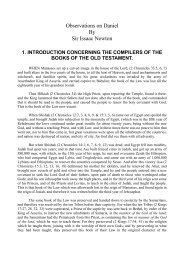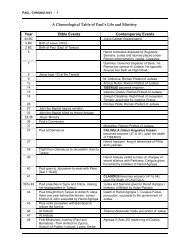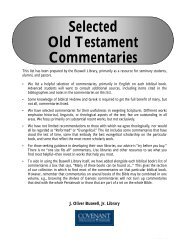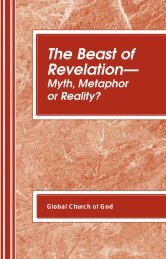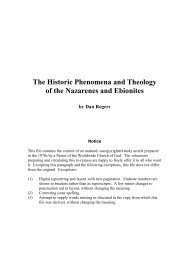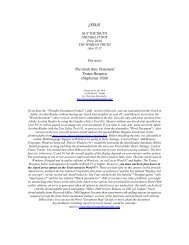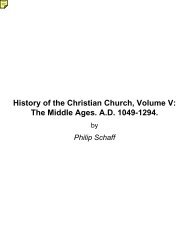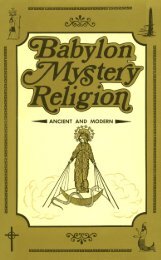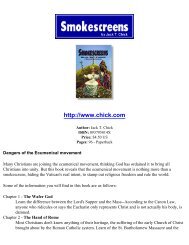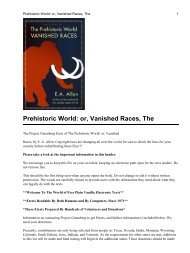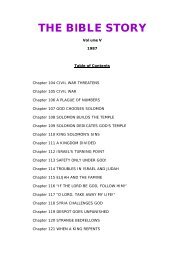Plain Truth 1957 (Vol XXII No 07) - Herbert W. Armstrong Library ...
Plain Truth 1957 (Vol XXII No 07) - Herbert W. Armstrong Library ...
Plain Truth 1957 (Vol XXII No 07) - Herbert W. Armstrong Library ...
You also want an ePaper? Increase the reach of your titles
YUMPU automatically turns print PDFs into web optimized ePapers that Google loves.
July, <strong>1957</strong> The PLAIN TRUTH<br />
THE RACE QUESTION<br />
38 and 39. <strong>No</strong>tice the identity of Gog<br />
and Magog.<br />
Who are the people called “Gog” and<br />
“Magog”? Magog, rather than Gog, is<br />
mentioned in Genesis 10:2. Gog is ap-<br />
parently a tribal subdivision of Magog.<br />
In prophecy, Magog comes to great<br />
prominence in the West only in the lat-<br />
ter days.<br />
Here is what the Jewish Encyclopae-<br />
dia says about Gog and Magog: ‘* . . .<br />
[a] wall [was) built by . . . (Alexander<br />
the Great) to shut them off from the<br />
rest of the world. . . . Geographically<br />
they represent the extreme northeast, and<br />
are placed on the borders of the sea thut<br />
encircles the earth.”<br />
<strong>No</strong>tice what the unrivalled McClin-<br />
tock and Strong Encyclopaedia says about<br />
Gog and Magog: “According to Rein-<br />
egge (Descri$. of the Camasus, ii, 79),<br />
some of the Caucasian people call their<br />
mountains Gog, and the highest north-<br />
ern points Magog”-because the people<br />
of Magog once lived in these regions in<br />
Bible times! “The Arabians are of the<br />
opinion that the descendants of Gog and<br />
Magog inhabit the northern parts of<br />
Asia, beyond the Tartars and Sclavon-<br />
ians [or Russians), and they put Yujuj<br />
and Majuj always in conjunction, there-<br />
by indicating the extreme points in north<br />
and north-east of Asia” (from art.<br />
“Gog” ) .<br />
Some writers spell these Arabic words<br />
Yagog and Magog. <strong>No</strong>w to what people<br />
are these names referring? They dwell<br />
in the northern part of Asia, bordering<br />
on the ocean, and rise to prominence<br />
with the Russians of Europe “in the lat-<br />
ter days” ( Ezek. 38 : 8 ) .<br />
The Mongols and their Asiatic kins-<br />
men! In fact, the proper spelling of<br />
“Mongol” is “Mogol,” obviously a<br />
slightly changed form of “Magog”! And<br />
in Asiatic Russia live the Yakuts-the<br />
Yagog of the Arab historians.<br />
Mongolia today is in the Russian<br />
sphere of influence. The people of Mon-<br />
golia, together with China, Manchuria,<br />
Korea and Japan, are all of this one<br />
great branch of mankind.<br />
A remnant of the people of Magog<br />
appear, with pigtails and yellow skin,<br />
( Continged from page 14)<br />
on the Egyptian monuments. They were<br />
called Kheta by the Egyptians and Ketei<br />
by the Greeks. (See article “Hittites” in<br />
Inter. Stand. Bib. Ency.) When the RUS-<br />
sians first met the Mongolians and Chi-<br />
nese they called them Khitbi! Western<br />
Europeans used a similar word for China<br />
in the Middle Ages: Cathay (Ency. Brit.,<br />
art. “China”). Here indeed is “Gog, of<br />
the land of Magog.”<br />
Both Russia and China are Commu-<br />
nist partners. And they will remain so<br />
until the end of this age!<br />
Since we are dealing with Commu-<br />
nist nations, it is time we located the<br />
sons of Gomer (Gen. 10:2).<br />
Gomer <strong>No</strong>t In Europe<br />
Look in your Bible for a map-if you<br />
have one in your Bible. There you will<br />
probably have pictured the descendants<br />
of Gomer migrating into Europe! <strong>No</strong>th-<br />
ing could be further from the truth.<br />
They migrated in exactly the opposite<br />
direction!<br />
But do you know why many have as-<br />
sumed that Gomer may be in modern<br />
Europe today? Because the people of<br />
<strong>No</strong>rthwest Europe journeyed through<br />
the land of Gomer before coming to<br />
Europe and were therefore called Kym-<br />
mri! Prophecy says this very fact would<br />
occur! <strong>No</strong>tice what Israel is called while<br />
in captivity: “Gomer” (Hosea 1 : 3 ) . The<br />
woman “Gomer” mentioned by the<br />
prophet had the same name which the<br />
children of Israel bore when coming into<br />
Europe! The Israelites were called Khu-<br />
mri or Cymmri, or Khmeri, or Cimme-<br />
rians upon reaching northwest Europe.<br />
But where are the descendants of<br />
Gomer today?<br />
Gomer originally settled northeast of<br />
Elam. From here they were driven to<br />
the Caucasus, between the Black and the<br />
Caspian Sea. Then they journeyed to<br />
Southeast Asia! <strong>No</strong>tice!<br />
The native name for Cambodia in<br />
Indo-China is Khmer-the land of Go-<br />
mer! Read the Britannica article on<br />
Cambodia.<br />
Associated with Gomer are the Chams<br />
and Annamese. Could this be only a<br />
coincidence?<br />
Page 17<br />
The Cambodians are related to the<br />
Siamese, Burmese and other brown Mon-<br />
goloids of the Indonesian Isles and the<br />
Philippines. In the ancient land of Go-<br />
nier dwelled a small tribe called the<br />
Lullu (Ency. Biblica, map opposite<br />
Syria). In extreme South China today<br />
dwell the Lulu, a non-Chinese race re-<br />
lhted to the people of Southeast Asia!<br />
One branch of the family of Gomer,<br />
however, did not journey to Southeast<br />
Asia. Ezekiel 38:6 explains it: “The<br />
house of Togarmah in the uttermost<br />
parts of the north, and all his bands”<br />
(Jewish translation). The far, far north<br />
means Russian Siberia today! That is<br />
where the descendants of Togarmah<br />
(Gen. 10:3) live. These Asiatics are<br />
still a wild nomadic people, much as<br />
they were 2500 years ago, trading “with<br />
horses and horsemen and mules” (Ezek.<br />
27: 14).<br />
Ezekiel 38, then, contains a prophecy<br />
that Southeast Asia will fall to the Com-<br />
munists!<br />
The Middle East In Prophecy<br />
Communist-inspired trouble is boil-<br />
ing up in the Middle East. Syria is now<br />
the focal point of intrigue. Where is<br />
Syria mentioned in the Bible? Who are<br />
the Syrians?<br />
The Syrians are the descendants of<br />
Aram, a son of Shem. Everywhere in the<br />
Old Testament where the word “Syria”<br />
or “Syrian” appears in English, the word<br />
in Hebrew is Aram or Aramean. The<br />
Arameans were called Syrians by the<br />
Greeks because they once formed part<br />
of the Assyrian Empire dominated by<br />
Asshur, the Germanic people.<br />
<strong>No</strong>w we are about to find an unususl<br />
characteristic of the children of Aram.<br />
Aram had four sons listed in Genesis<br />
10: 23 : Uz, Hul, Gether and Mash. Com-<br />
pare this with I Chronicles 1: 17. Here<br />
the sons of Sbem include “Arm, AND<br />
Uz, and Hal, and Gether, and Meshech.”<br />
First, notice that the sons of Aram are<br />
raised to the level of brothers in I Chron-<br />
icles I-they are on an equal footing<br />
with their uncles! Further, the name<br />
Mash is changed into Meshech, because<br />
Mash became associated with Meshech,<br />
the son of Japheth!<br />
Why should these sons be elevated<br />
to the position of fathers of distinct peo-<br />
ples? Because the sons of Aram must



